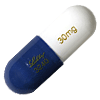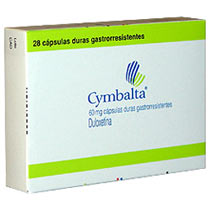Generic Cymbalta (Duloxetine): Dosage and Uses, Withdrawal, Cymbalta for Fibromyalgia, Cymbalta and Weight Loss, Cymbalta and Alcohol, Drug Interactions, Cymbalta and Pregnancy, Contraindications and Side Effects, Cymbalta Abuse
CONTENT

- Cymbalta Generic Name
- Cymbalta Dosage
- Withdrawal
- Cymbalta Uses
- Cymbalta for Fibromyalgia
- Cymbalta for Pain
- Cymbalta and Weight Loss /Weight Gain
- Cymbalta and Hair Loss
- Cymbalta and Alcohol
- Drug Interactions
- Cymbalta Half-Life
- Cymbalta and Pregnancy
- Cymbalta Breastfeeding
- Counter-Indications
- Side-Effects
- Cymbalta Abuse
Cymbalta is a medication with anti-depressant effect. Its active substance is duloxetine which belongs to the group of united serotonin and norepinephrine reuptake inhibitor.
Cymbalta Generic Name
Along with its brand name, Cymbalta has a generic analogue named Duloxetine Oral. Its chemical composition and effect are identical.
Cymbalta Dosage
Cymbalta is taken perorally regardless of food acceptance with a lot of water. Capsules should be taken without chewing and mashing. Cymbalta shouldn’t be added to food or mixed with liquids, since it may damage enteric coating. During the intake a patient should avoid damage of coating integrity of the capsule. Dosage of Cymbalta depends on the severity and character of disease. There are two principle dose gradations of Cymbalta: Cymbalta 30mg and Cymbalta 60mg.
Cymbalta 30 mg
- General anxiety disorder. The recommended initial dose is 30 mg/day regardless of food acceptance. Patients not experiencing the effect may increase dosage to 60 mg once a day. In order to avoid repetition after response on antidepressant therapy, it is recommended to continue treatment within several months.
- Aged patients. In order to treat general anxiety disorder it is recommended to start with 30 mg during 2 weeks before duloxetine intake in its targeted dose of 60 mg/day.
Cymbalta 60 mg
- Initial and recommended maintenance dose is equal to 60 mg once a day regardless of food acceptance. During clinical trials, the assessment of doses application from 60 up to 120 mg/day was conducted. Nevertheless, the supposition that non-responsive to initial dose patients had any improvements after dose increase was not clinically confirmed. Treatment response is generally observed in 2-4 weeks after initial intake. In order to avoid repetition after response on antidepressant therapy, it is recommended to continue treatment within several months.
- Painful form of peripheral diabetic neuropathy. Maximum daily dosage is 60 mg per day. During clinical trials the safety of Cymbalta dosage of 60 up to maximal dose of 120 mg/day was estimated. Duloxetine concentration in blood plasma of patients is characterized by considerable individual variability. Therefore, some patients with insufficient dose response (60 mg/day) may have improvement after administration of higher dose. The response assessment may be conducted after two months.
- Chronic pain syndrome of skeletomuscular system. The initial treatment should be started with the dose of 60mg once a day. Efficiency of Cymbalta in fibromyalgia treatment was demonstrated by placebo-controlled studies lasting three months. Trials lasting longer didn’t show Cymbalta efficiency. Anyway, continuation of treatment must be grounded on individual patient’s response.
- Renal disorder. In case CI creatinine is 30-80 ml/min, correction of dosage is not required. In lesser indicators, Cymbalta is counter-indicative.
Patients with hepatic failure leading to hepatic decompensation are prohibited to administer Cymbalta. It is not recommended for children under 18 years of age because of important lack of data.
Cymbalta Withdrawal
Sudden therapy withdrawal should be avoided. In case of Cymbalta withdrawal, dosage should be decreased during 1-2 weeks in order to decrease the risk of withdrawal syndrome development. If after the dose reduction and treatment cessation, withdrawal syndrome symptoms occur, the continuance of earlier prescribed dosage may be considered. As a result, a physician may prolong the dose decrease but more gradually.
Cymbalta Uses
 Cymbalta is applied for treatment of major depressive disorder and generalized form of anxious disorder. Cymbalta is also used in therapy of peripheral diabetic neuropathy (with pronounced pain syndrome). Duloxetine insignificantly inhibits dopamine reuptake, and practically doesn’t have affinity to histaminic, cholinergic, dopamine, and adrenergic receptors. Efficiency of the drug in treatment of depression is explained by inhibition of serotonin and norepinephrine reuptake causing the enhancement of noradrenergic and serotonergic neurotransmission in central nervous system.
Cymbalta is applied for treatment of major depressive disorder and generalized form of anxious disorder. Cymbalta is also used in therapy of peripheral diabetic neuropathy (with pronounced pain syndrome). Duloxetine insignificantly inhibits dopamine reuptake, and practically doesn’t have affinity to histaminic, cholinergic, dopamine, and adrenergic receptors. Efficiency of the drug in treatment of depression is explained by inhibition of serotonin and norepinephrine reuptake causing the enhancement of noradrenergic and serotonergic neurotransmission in central nervous system.
Cymbalta also takes analgesic action which is theoretically explained by decrease of pain impulses rate to CNS decrease. After its peroral intake, duloxetine is well absorbed (the time of peak concentration in blood serum is six hours). Food prolongs the time of peak concentration achievement (by four hours in comparison with fasted intake) and decreases the level of medication in blood plasma (by 11%). More than 90% of duloxetine in blood serum is in bound state.
Cymbalta for Fibromyalgia
Efficiency of Cymbalta in fibromyalgia treatment was demonstrated by placebo-controlled studies lasting three months. Trials lasting longer didn’t show Cymbalta efficiency. Anyway, continuation of treatment must be grounded on individual patient’s response.
Cymbalta for Pain
In case of stable neuropathic pain, a patient should administer Cymbalta. Neuropathic pain is a variety of pain which in comparison with traditional pain occurs not as a result of physical injury, but caused by firing of neurons in peripheral or central nervous system responding to the reaction on physical damage of organism (traditional pain)
Cymbalta and Weight Loss /Weight Gain
Some patients during therapy course indicated the weight instability, increase of cholesterol and creatinine phosphokinase level. Sudden Cymbalta withdrawal may lead vomit, nausea, headache, vertigo, hyperhidrosis, irritation, altered defecation pattern, tremor, as well as sensitivity and sleep impairment.
Cymbalta and Hair Loss
Hair loss has been reported by patients taking Cymbalta especially by women of 60 years and older. They took medication from 1 to 6 months, suffered from depression and might also use Lyrica. Nevertheless, there is not clinically proven data reporting hair loss from Cymbalta intake.
Cymbalta and Alcohol
Alcohol cannot be combined with Cymbalta, since ethanol to some extent prolongs action of intracerebral serotonin and acts as a inducer of dopamine synthesis (like monoamine oxidase inhibitors which are incompatible with alcohol). Therefore, on the one hand simultaneous intake of alcohol with antidepressants may compete for substrate resulting in enhancement of not so much direct effect of Cymbalta, as its side-effects. These side-effects may be represented by hallucinations, depressive psychosis, and sexual disorders. Put potentially more dangerous condition may be development of serious autonomic disturbances, such as jump in pressure, clotting disorder, secretory disorders and arrhythmia.
Cymbalta and Drug Interactions
Medications metabolized with participation of CAP1 A2 do not influence the efficiency of duloxetine. But the intake of stronger CYP1 A2 inhibitors may cause the increased level of duloxetine in blood. Thus, co-administration of Cymbalta with CYP1 A2 inhibitors is not recommended. Duloxetine moderately inhibits CYP2 D6. So, if a patient decides to combine the intake of CYP2 D6 with Cymbalta may increase the level of the latter in blood serum. Duloxetine should be prescribed with care along with sedatives or other medicines inhibiting central nervous system including tricyclic antidepressants, tryptophane and tramadol. Monoamine oxidase inhibiting agents must not be co-administered with duloxetine (including the period of 4 weeks after termination treatment with monoamine oxidase inhibiters). Cymbalta may enhance bleeding risk on the setting of its combination with anti-thrombotic and anticoagulant remedies.
Cymbalta and Xanax
Co-usage of these remedies may cause the increase of side-effects including vertigo, concentration difficulty, confusion, drowsiness. Some patients, especially elderly ones may also feel judgment, thinking and motor coordination impairment. You should consult a specialist before taking Cymbalta and Xanax simultaneously.
Cymbalta and Tramadol
Cymbalta should be administered with care along with sedatives or other medicines inhibiting central nervous system including tramadol.
Cymbalta and Wellbutrin
You have to consult a specialist before you take decision of co-administration of Wellbutrin and Cymbalta. Their combination may cause the increase of epileptiform fits which is a rare side-effect of each of the drugs. Wellbutrin is able to enhance duloxetine blood level causing the increase of other side-effects.
Cymbalta and Lyrica
Co-usage of these remedies may cause the increase of side-effects including vertigo, concentration difficulty, confusion, drowsiness. Some patients, especially elderly ones may also feel judgment, thinking and motor coordination impairment. You should consult a specialist before taking Cymbalta and Lyrica simultaneously.
Cymbalta and Hydrocodone
Co-administration of Cymbalta and Hydrocodone may increase undesired effects, such as confusion, vertigo, concentration difficulty, and drowsiness. These agents cannot be combined with alcohol. Some patients, especially elderly ones may also feel judgment, thinking and motor coordination impairment. You should consult a specialist before taking Cymbalta and Hydrocodone simultaneously.
Cymbalta and Vyvanse
You should have a consultation by a medical specialist before using Cymbalta along with Vyvanse. Their co-administration may lead to enhancement of side-effects, such as restlessness, jitteriness, anxiety, nervousness, racing thoughts. Another severe condition which may be caused by this combination is a so-called serotonin syndrome including the following symptoms: fever, hallucination, shivering, jumps in blood pressure, heartbeat rate increase, seizure, confusion, etc.
Cymbalta Half-Life
Half-life period of Cymbalta active substance takes around 12 hours in case of average clearance of 101 l/hour. Terminal stage of renal decompensation cause double increase of duloxetine and exposition rate.
Cymbalta and Pregnancy
Duloxetine wasn’t researched during bearing a child. Thus, Cymbalta intake during pregnancy is not recommended. Possibly, Cymbalta intake during pregnancy may cause withdrawal syndrome, increased reflectory excitability, irregular breathing, swallowing and sucking among children. In some cases epileptic seizures may occur among newly-born. If you plan to conceive, you should consult your attending doctor before using Cymbalta.
Cymbalta Breastfeeding
The dose of duloxetine getting into milk is around 0,14% of a dose taken by a mother. Cymbalta is not recommended to lactating women.
Cymbalta Counter-Indications

Cymbalta must not be administered if a patient is hypersensitive to any of its components.
Also, contraindications to Cymbalta usage run as follows:
- Unstable hypertension;
- Impaired renal function;
- Hepatic pathologies;
- Usage of inconvertible non-selective monoamine oxidase inhibitors;
- Combined intake with fluvoxamine, enoxacin, and ciprofloxacin.
- Pediatric use.
Cymbalta should be taken with care:
- by patients with underlying risk for suicide;
- epileptic seizures, manic-depressive psychosis;
- ocular hypertension, risk of narrow-angle glaucoma;
- arterial hypertension, cardiac pathologies and cardiac rhythm and heart failure;
- high risk of hyponatremia;
- intake of drugs with hepatotoxic action.
During the intake of Cymbalta, a patient should refuse driving and controlling of potentially dangerous types of equipment.
Cymbalta Side-Effects
- From the part of nervous system: sleep impairment, anomalous orgasm, bruxism, disorientation, anxiety, hallucinations, mania.
- From the part of sense organs: vision impairment, mydriasis, eye dryness, glaucoma, pain and singing in ears.
- From the part of cardio-vascular system: tachycardia, atrial fibrillation, supraventricular arrhythmia, heartbeats, fainting, blushing, postural hypotension, instability of arterial blood pressure, extremity coldness, hypertensic crisis.
- From the part of respiratory system: nasal bleeding, pharyngalgia, oscitancy.
- From the part of organs of digestion: hyperglycemia, anorexia, altered defecation pattern, dyspepsia, stomachaches, excessive gas, gastro-intestinal bleeding, belching, gastritis, offensive breath, stomatitis, blood in feces.
- From the part of liver: hepatitis, increased level of hepatic enzymes, hepatic decompensation.
- From the part of urinary system: urination detention, nocturia, slowing of urinary stream, change of urinary smell.
- From the part of reproduction system: menstrual disorders, erectile dysfunction, ejaculation issues, uterine bleeding, galactorhea, hyperprolactinemia, menopause symptoms.
- Allergic reactions: rashes, sweating, angioneurotic edema, contact dermatitis, urticarial fever, pholosensibility, Stevens Johnson’s syndrome, acute serum sickness.
Cymbalta Abuse
Information about Cymbalta overdose is limited. It was reported of several cases of duloxetine intake in one-time dosage of 1400mg (along with cases of co-administration with other drugs) with positive result. Cymbalta overdose may cause epilepsy, vomit, serotonin syndrome and drowsiness. Specific antidote of duloxetine is unknown. In case of serotonin syndrome occurrence, a specific therapy is recommended.

